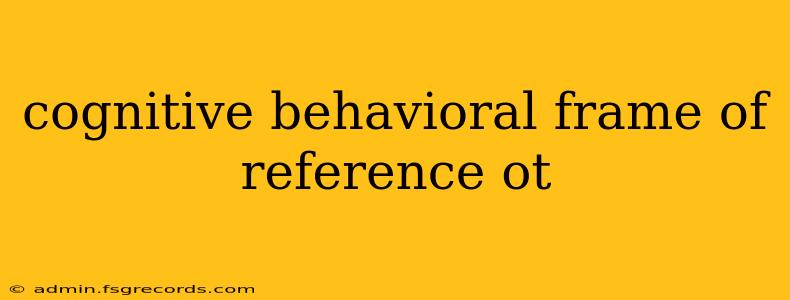The Cognitive Behavioral Frame of Reference (CBT) is a widely used therapeutic approach that focuses on the interconnectedness of thoughts, feelings, and behaviors. This framework posits that our thoughts significantly influence our emotions and actions, and by modifying maladaptive thought patterns, we can improve our overall psychological well-being. This guide delves into the core principles, techniques, and applications of the CBT frame of reference.
Core Principles of the CBT Frame of Reference
The CBT frame of reference rests on several fundamental principles:
-
The Cognitive Triad: This core concept emphasizes the interplay between negative thoughts about oneself, the world, and the future. These negative thought patterns often perpetuate and reinforce each other, leading to a cycle of depression, anxiety, or other mental health challenges.
-
Cognitive Distortions: CBT identifies common thinking errors, or cognitive distortions, that contribute to psychological distress. These include all-or-nothing thinking, overgeneralization, mental filtering, discounting the positive, jumping to conclusions, magnification (catastrophizing), and emotional reasoning. Identifying and challenging these distortions is a key element of CBT therapy.
-
Behavioral Activation: This principle highlights the importance of engaging in activities that promote positive emotions and a sense of accomplishment. By gradually increasing participation in enjoyable and rewarding activities, individuals can break free from the cycle of avoidance and inactivity often associated with mental health difficulties.
-
Schema Therapy: In more complex cases, CBT may integrate schema therapy, which explores deeply ingrained maladaptive patterns of thinking and relating developed in early childhood. These schemas influence how individuals perceive and interact with the world, often contributing to long-standing psychological issues.
Key Techniques Used in CBT
CBT utilizes various techniques to help individuals identify and modify maladaptive thoughts and behaviors:
-
Cognitive Restructuring: This technique involves identifying and challenging negative or distorted thoughts, replacing them with more realistic and balanced perspectives. This often involves using Socratic questioning to help clients arrive at their own conclusions.
-
Behavioral Experiments: These are designed to test the validity of negative beliefs through direct experience. For example, a client fearing social rejection might participate in a planned social interaction to gather evidence contradicting their fear.
-
Exposure Therapy: This technique is particularly useful for treating anxiety disorders. It involves gradually exposing individuals to feared situations or stimuli in a safe and controlled environment, helping them to reduce their anxiety responses over time.
-
Relaxation Techniques: Methods like progressive muscle relaxation, deep breathing exercises, and mindfulness meditation are often integrated into CBT to manage anxiety and improve overall emotional regulation.
Applications of the CBT Frame of Reference
The CBT frame of reference is remarkably versatile and applicable to a wide range of mental health conditions, including:
-
Depression: CBT helps individuals identify and challenge negative thought patterns contributing to depression, and promotes behavioral activation to increase engagement in life.
-
Anxiety Disorders: Techniques like exposure therapy and relaxation training are effectively used to address specific anxiety symptoms, such as phobias, panic attacks, and generalized anxiety.
-
Post-Traumatic Stress Disorder (PTSD): CBT can help individuals process traumatic memories, challenge unhelpful beliefs, and develop coping mechanisms to manage PTSD symptoms.
-
Eating Disorders: CBT addresses distorted body image, unhealthy eating behaviors, and underlying emotional issues contributing to eating disorders.
-
Substance Abuse: CBT assists individuals in identifying triggers for substance use, developing coping skills for cravings, and modifying maladaptive thought patterns related to substance abuse.
Conclusion
The Cognitive Behavioral Frame of Reference offers a powerful and evidence-based approach to understanding and addressing a wide spectrum of psychological challenges. By focusing on the interplay of thoughts, feelings, and behaviors, CBT empowers individuals to take an active role in modifying their patterns of thinking and behaving, ultimately leading to improved mental health and overall well-being. Its versatility and effectiveness make it a cornerstone of modern mental health treatment.

